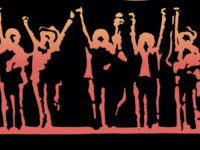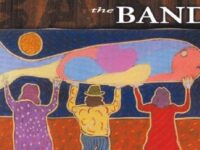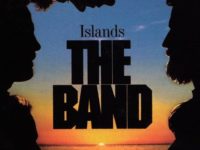Garth Hudson receives a rare moment of individual recognition this weekend, as the endlessly inventive co-founding multi-instrumentalist in the Band is inducted this weekend into the London Music Hall of Fame. A native of Windsor, Ontario, Hudson and his very musical family moved to London when he was still a child. Classically trained, the youngster would write his first song at the tender age of 11.
In fact, Hudson’s rise to fame, ultimately helped secure Sunday night’s honor, only because he’d convinced his parents not that he was joining a randy rockabilly act led by Ronnie Hawkins — but that he was giving music lessons to the Hawks’ youthful backing band. Those kids, with the addition of Hudson, would eventually split off to become a now-legendary act simply called the Band.
Pioneers in a format now called Americana, the group was active, in its original incarnation with Robbie Robertson, from 1964–1977, and then in a lineup centered on Hudson’s partnerships with Rick Danko and Levon Helm from 1983–1999. (Richard Manuel, who completed the initial quintet, died in 1986.) Since, Hudson has focused on musical collaborations with Sister Maud Hudson, his wife and companion of some four decades.
Both joined us, in this exclusive Something Else! Sitdown, to talk about Hudson’s early inspirations, the impact of the Lowry organ, his early days with the Hawks, and how those influences flowed into a signature multi-artist project he led that reanimated songs Hudson felt the strongest connections with while in the Band.
The now-76-year-old Hudson is being be inducted along with John Noubarian, a jazz pianist, during the 10th annual Jack Richardson Music Awards — named after the Canadian producer who worked with the Guess Who (American Woman), Bob Seger Night Moves), Badfinger (Say No More), Alice Cooper (Love It to Death) and Poco (Crazy Eyes) among others. The gala is set for April 13, 2014 at the London Music Hall …
NICK DERISO: How did you discover an interest in music?
GARTH HUDSON: The basement had a darkroom, where my dad did his photography. I would go down there, and eventually I put a radio in with a copper wire. I drilled a hole through the floor of my bedroom and out into the back porch — and that was the aerial. I was picking up [legendary early rock ‘n’ roll DJ] Alan Freed, when I was about 14 or 15. Suddenly, I realized that somebody over there who was having lot more fun than I was! Richard Manuel and myself got all of our R&B education from across the water. I would go down and listen to “Moondog Matinee.” That’s a bit of rock ‘n’ roll history, and it emphasizes how important radio announcers were.
NICK DERISO: What led you to the organ?
MAUD HUDSON: You helped your dad with a project, right?
GARTH HUDSON: He started buying these pump organs. We had one in the living room, and one on the back porch and one in the cottage on the north shore of Lake Erie. I did the wood working, the metal work, learned how to use tools. I still have 14 or 15 of those screwdrivers. You had to glue all of it back together. There were were wooden pieces that were broken out, and it had dirt in the reeds. You had to take each reed out, and clean it off, and then put it back in.
NICK DERISO: The Band’s first few albums seemed to come out of nowhere in the late 1960s, cutting right through the psychedelia and acid rock of the day. How did you arrive at that fascinating amalgam of sounds?
GARTH HUDSON: The basics of it included rockabilly, and that gradually changed when Robbie came in the group. Then you start to hear more of the Delta guitar players, like B.B King. Robbie was instrumental in changing us from rockabilly to rock blues. Richard and I got our education from Alan Freed, because we were closer to Cleveland. Over there in the east, where Rick and Robbie came from, they picked up “The Hound” from Buffalo. We were tutored by different radio announcers.
NICK DERISO: Together, you created something that hadn’t been made before. They call it “Americana” these days. But back then, it didn’t even have a name — much less a radio format.
GARTH HUDSON: At first, we played what you would call cover material, but the very best that could be found — from Delta blues through the guitar and harmonica tradition and up through the uptown players. I think that puts it briefly. Richard admired Bobby “Blue” Bland as a singer, for example, and Ray Charles. We had all our sources. I admired Charles Brown as a singer and piano player. He was very smooth. I found out later on that he played stride and pop songs, or “AABA” songs, very well and had a considerable repertoire. As you think back, during the period he was playing, Nat Cole was also playing. Remember that Nat Cole took the guitar player that was playing with Charles Brown – Oscar Moore. So, there was overlap. All of it blended together.
[SOMETHING ELSE! REWIND: Across the Great Divide is a weekly, song-by-song examination from Something Else! on the legacy of the Band, both together and as solo artists. Click here to see past entries.]
NICK DERISO: Your recent Canadian Celebration of the Band illustrated how vibrant these songs still are, with interesting new interpretations from Neil Young, the Sadies and the Trews — who did a brilliant take on “Move to Japan,” from the Band’s 1993 release Jericho.
GARTH HUDSON: We came back to listen to the track and the drummer for the Trews started with this Newfie dockworker accent. It was really funny. I said: “Get on the mic,” and he did about 12 introductions — many of them somewhat like what you heard. But it had some cursing in there [laughs], so I had to go through the whole thing and what you eventually hear is an edited version. I would select one bit and then another. Every one of his pieces, which were introduction length — all of them were different. [Laughs.] I had to go through them all. He’s a bright lad.
MAUD HUDSON: As long as I’ve known Garth, people ask him: “What are your favorite Band songs?” And he always avoided answering. [Laughs.] He never told anybody. So, this album, he’s answering that. They are the songs that Garth had the most fun with, that he enjoyed the most — whether it was for the chords and the structure of the song, or the story that it tells or the humor in it. And he didn’t match the artist to the song, because that’s their style. In fact, sometimes, he deliberately picked something that was counter to their sound. All the boys wanted to do “It Makes No Difference,” and all of the girls wanted to do “Evangeline.” [Laughs.] But that isn’t what Garth had in mind for the album.
NICK DERISO: What was it like working on those familiar songs with different musicians? I was blown away, for instance, by the new take on “Chest Fever” from Ian Thornley and Bruce Cockburn. Was there a new spark?
GARTH HUDSON: Oh, certainly. Certainly. As far as my accompaniment and solos and so on, in between these folks, I think it did spurn me onward. Hearing different interpretations like Ian Thornley, he had —
MAUD HUDSON: He came to it from such an innocent place. This album was his first exposure to it. So it was the best take.
GARTH HUDSON: Oh, yeah. He changed the phrasing. It’s a great piece of work.
NICK DERISO: By the time of the Band recordings, you had begun using a Lowrey. It gave your music such a distinctive feel — primarily because the Hammond B3, at that point, was standard.
GARTH HUDSON: Early on, it was all on the Lowrey FL, then later on the Lincolnwood, and then the big one — the H25. All of the textures and so on are from Lowreys. I’ve tried to describe why a Lowrey fit right in with our guitar work, and the singing — it complements the voices. One reason for using an organ other than the Hammond is that the Lowrey has a wider harmonic structure. It has, I think, 27 different harmonics at various levels to get a sound, while the Hammond has eight or nine. A Hammond always sounds like a Hammond. And of course, the Jimmy Smith sound — that percussive sound — it’s obvious, when you hear that, this is a Hammond organ. The newer digital organs that have the Hammond name on them, a friend of mine told me they sound very close — almost like a digital clone, but I don’t know. The Lowrey was always a lot more interesting to me.
NICK DERISO: Of course, “The Genetic Method” became a clinic on the Lowrey’s versatility and power.
GARTH HUDSON: I know I stole something from J.S. Bach there. But we needn’t mention that, right? [Laughs.]
- How Deep Cuts on ‘Music From Big Pink’ Underscore the Band’s Triumph - July 31, 2023
- How ‘Islands’ Signaled the Sad End of the Band’s Five-Man Edition - March 15, 2022
- The Band’s ‘Christmas Must Be Tonight’ Remains an Unjustly Overlooked Holiday Classic - December 25, 2016




